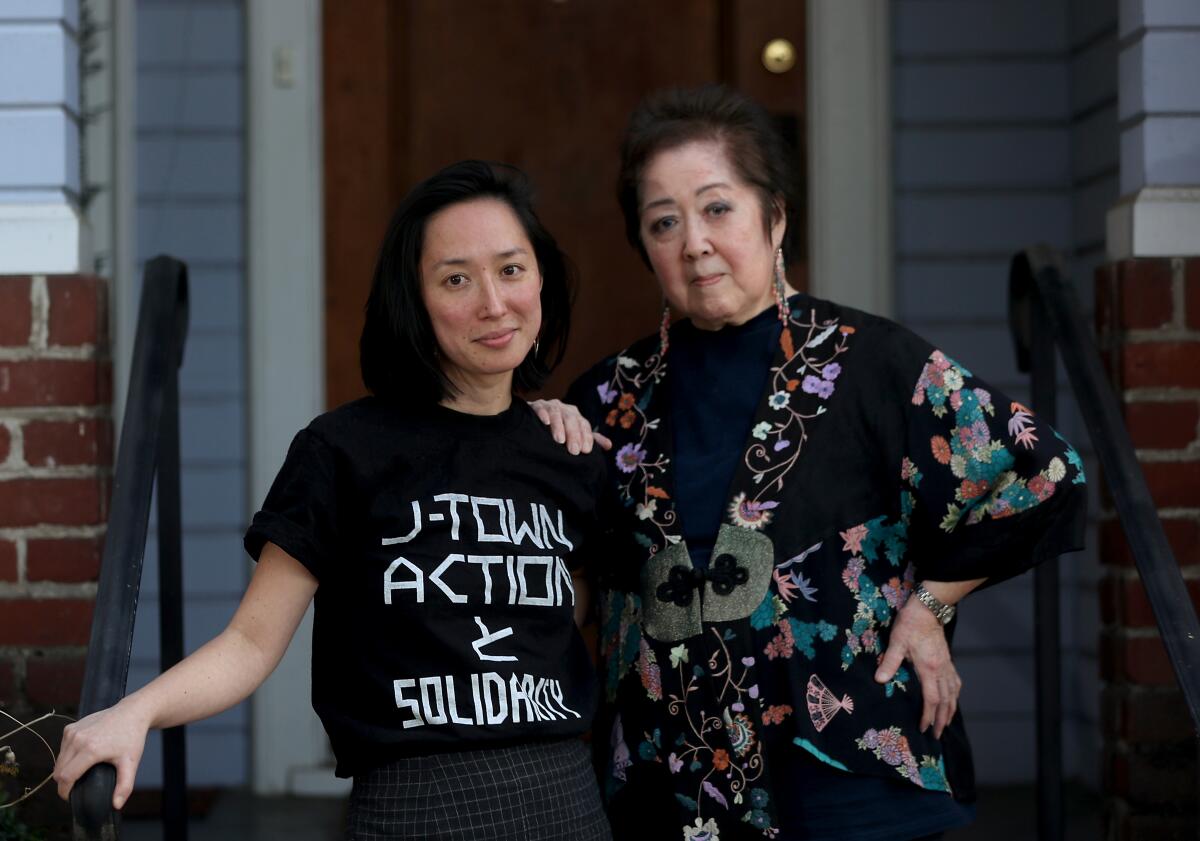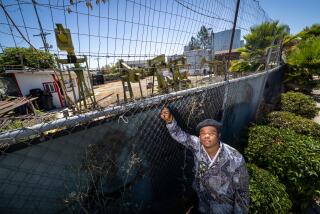Q&A: Two generations of Asian American activists on making the most of this moment

- Share via
A year after the coronavirus started spreading across the globe, Asian American activists have ignited a movement against racism.
Propelled by former President Trump’s vitriolic comments about the “China virus,” there has been an uptick in hate crimes. Members of the Asian American and Pacific Islander community were already rallying and ringing alarm bells before a white gunman allegedly shot and killed eight people in Atlanta spas, six of them Asian women, on March 16.
The massacre has opened the public’s eyes, and Asian American activists are hoping to harness the momentum and turn it into sustained action.
Ana Iwataki, 32, started working on J-Town Action & Solidarity, which partners with We the Unhoused to provide homeless people in Little Tokyo with resources such as clothing, food and hygienic products.
In the aftermath of the Atlanta attacks, J-Town has ramped up its efforts to collaborate with L.A.-area Asian American groups.
Iwataki is guided by a powerful teacher, her aunt Miya Iwataki, who started her work as an activist in the 1960s under the wings of the Brown Berets, a seminal Chicano rights group.
In the 1980s, Miya Iwataki helped Japanese Americans win reparations for their incarceration by the U.S. government during World War II.
On Tuesday, Ana and Miya spoke with The Times about their different perspectives as part of two generations of Asian American activism.
How does the activism of the past inform younger generations working against hate today?
Miya: For decades, most people didn’t know that there was an Asian revolutionary movement in the ’60s and ’70s and that our programs were really inspired by groups like the Black Panther Party.
I came into the movement through the Brown Berets. When I was at Cal State Los Angeles, there were older Asian guys that used to meet in the back room of Ben Yano’s bar [The Alibi Club], and they talked about Malcolm X or whatever the issues were of the time. When I finally went to one of the meetings, a leader of a United Farm Workers grape boycott and the leadership of Brown Berets were there. When Asians began to organize, we had models already.
The Black Panthers were the ones that built free breakfast programs, free housing, clothing, health clinics, and those were the programs that inspired us in the Asian American movement. I think one of our principles has always been that we stand in solidarity with people who are the most oppressed.
Ana: It’s really important to note that there isn’t that much sense of a divide between the activists from back then and the people of my generation because there are intergenerational organizations where we’re able to learn from people like my aunt. [We] share our perspectives and, as conversations evolve, we have more language to talk about how to recognize all aspects of white supremacy that we have been fighting against for so long.
How have both of you helped each other in your activism?
Miya: I think with Ana’s generation, things have changed so much with media and technology. They are helping us, the older generation, keep up with the times. Without them, we couldn’t be moving forward in the way we have. They’re so whip smart. I’m so happy and proud and relieved. We’ve been around for a long time, and we’re getting kind of old.
Ana: I feel so fortunate. Over the summer, I was able to call my aunt after going to protests to ask her about some of the things that I was seeing and experiencing, such as issues about safety. She gave me such good advice. We also had a conversation about defunding the police and what abolition means. For me it’s so incredible to be able to have a guide as I learn how to be an organizer.
Miya: When she first texted me about working on defunding the police, that was something I had thought about but not really figured out exactly what that means. If it wasn’t for Ana, I wouldn’t be digging deeper into these issues.
Does this wave of Asian American activism feel like a turning point to you?
Miya: There are many turning points. This has been a turning point for a lot of people who may have not wanted to recognize that there is Asian hate. Unfortunately, there may be other turning points like this that happen.
Ana: If people can keep the momentum going and not just ride a wave of something that is floating around social media, but turn the fear and anger and pain into lasting action, then …
Miya: We have to keep the conversation going. I think there have been more news stories on Asian Americans in this past week or so than maybe in the entire year. I’m happy about that, but I hope this is not just a ripple in the ocean but that we can keep this conversation going and not just be forgotten about when April rolls around.
Asian Americans come from many countries with many languages and cultures. How have activists dealt with this challenge?
Miya: This is a really tough question. We are not a monolith, and there’s so many layers.
When I worked in health, one of the things my office was fighting for was to establish a culturally and linguistically competent infrastructure in the county health department, because prior to that there were maybe two languages offered: English and Spanish. Here we have all of these different Asian languages. Also, Asian countries have different histories with each other. With some of the elders, there’s these memories of their country being at war with or oppressed by other countries .... But issues like this are opportunities for us to work together.
Ana: It’s important always in any kind of coalition work to recognize that it’s possible to have differences and solidarity at the same time. That doesn’t have to be a block to building collective power. That’s why intersectionality always has to be part of the conversation. With these different immigration histories come different relationships to education, to class to everything.
How has social media played a role in the aftermath of horrific events like George Floyd’s death and the Atlanta massacre?
Ana: Our group has always been about on-the-ground work, but we recognize the importance of social media, especially in a pandemic. It’s tricky, though, because it’s easy to share the most simplistic version of the narrative, and that can be harmful in itself. It can reproduce harmful narratives, but it can also bring people to a different kind of narrative.
We definitely are fairly active on Instagram in particular, but because there is so much content going out, we’re trying to be really intentional about what we produce.
Miya: Ana is still trying to teach me how to do Instagram. It’s been kind of tough, but I see the good in it. It’s instant information. For example, a couple of weeks ago, one of our temples in Little Tokyo was vandalized. Nikkei Progressives put up a GoFundMe online. Overnight there was $60,000. It was just amazing how fast the word got out and how fast we were able to provide support.
I also wonder how many people are stuck behind their computers and how much on-the-ground activism there will be after we’re able to go out and about again. I hope it’s not going to be used as a crutch.
What is the best strategy for sustained change?
Ana: There’s so many levels to address these issues from, and mutual aid is one of them. It allows us to be in conversation with some of the most vulnerable people feeling the effects of white supremacy in the most intense ways and having the privilege to talk to them and understand their histories and their perspectives. It shapes our work in a profound way.
Miya: I think that protests and demonstrations are really important because it allows people to put a mass voice to what we’re protesting and what we want. Mutual aid, on the other hand, is an actual concrete step. It’s like an example of the type of society and quality of life that we’re all working toward. It’s putting your money where your mouth is.
More to Read
Sign up for Essential California
The most important California stories and recommendations in your inbox every morning.
You may occasionally receive promotional content from the Los Angeles Times.










